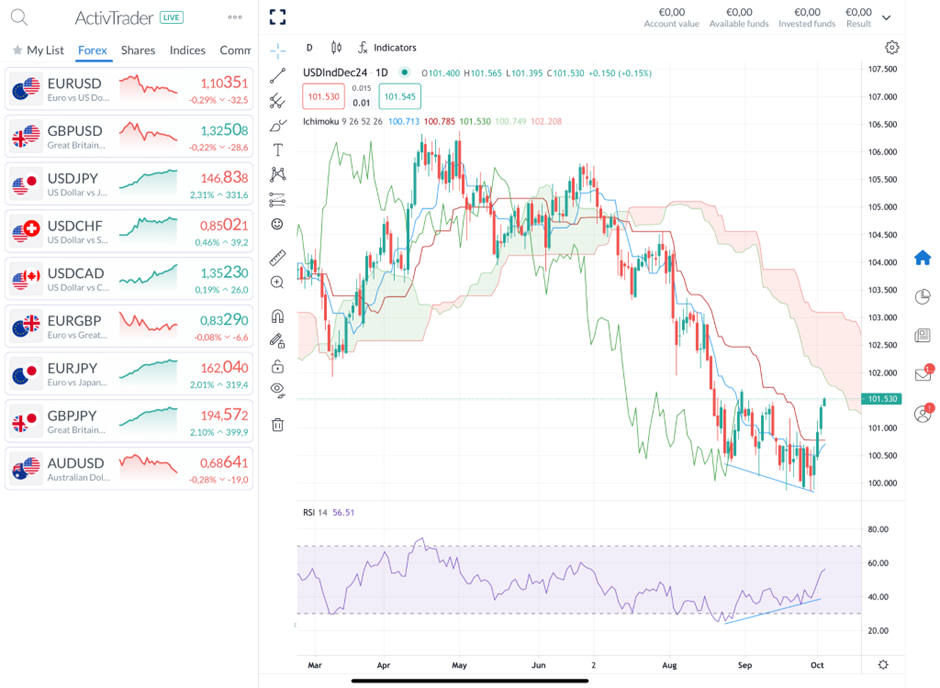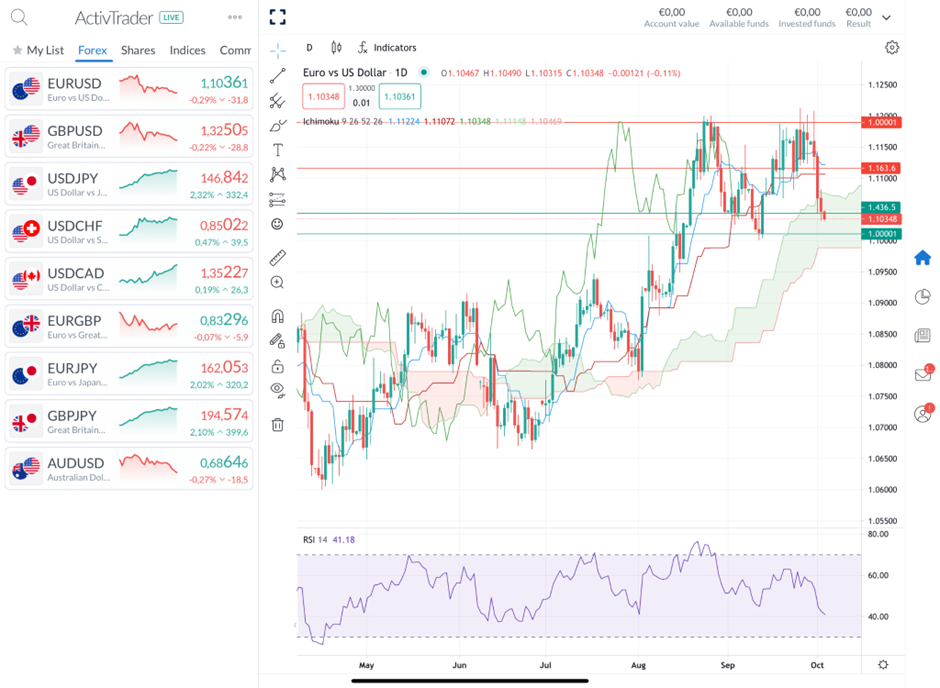Between Middle East Tensions & Monetary Policy: Is the Dollar Back?

Daily U.S. Dollar Chart - Source: ActivTrader
Beyond the geopolitical conflict, Federal Reserve Chair Jerome Powell’s recent remarks suggest a more cautious approach to interest rate cuts, which could further support the U.S. dollar. At the same time, the euro has been under pressure due to growing speculation that the European Central Bank (ECB) may implement additional rate cuts this month. This speculation has weakened the euro, driving investors to the more stable USD.
Let’s explore the key factors influencing the U.S. dollar’s recent performance and assess the potential for its continued strength.
Geopolitical Volatility: How the Iran-Israel Conflict Could Impact the U.S. Dollar
Rising tensions between Israel and Iran are intensifying concerns about broader geopolitical instability, a situation that could significantly impact the USD’s role as a global safe-haven currency.
The conflict escalated when Iran launched around 200 missiles at Israel, the majority of which were intercepted or missed their targets. This marked a significant escalation, placing Israel in a critical position to determine how it will retaliate. Israeli Prime Minister Benjamin Netanyahu issued a stern warning following the attack, stating, “Iran made a big mistake tonight—and it will pay for it,” underscoring the potential for further conflict.
This escalation follows 12 months of increasing clashes between Israeli forces, Gaza, and Hezbollah in Lebanon. The situation deteriorated after Israel killed a Hezbollah leader, and hours before Iran’s missile launch, the Israeli military had confirmed operations in Lebanon, where Hezbollah, an Iran-backed group, is based. The risk of a wider Middle East war is growing, with both sides preparing for further confrontation.
If the conflict intensifies, it could destabilise global financial markets and lead to higher demand for the USD as a safe-haven asset. Historically, during periods of geopolitical instability, investors seek refuge in the U.S. dollar, seen as a stable store of value. However, a prolonged conflict could also put upward pressure on oil prices, potentially causing inflation and complicating the global economic landscape, which may eventually weaken the dollar’s appeal in the longer term.
The situation now hinges on how Israel responds and whether other major actors, like the U.S., Russia, or Middle Eastern nations, get involved—further increasing market volatility.
ECB Rate Cut Speculation Weakens the Euro and Boosts the USD
The euro has been under pressure this week, driven by growing expectations that the European Central Bank (ECB) will cut interest rates further. Martins Kazaks, an ECB policymaker and Latvia’s central bank governor, recently pointed out mounting risks to growth in the eurozone, making a "clear-cut" case for a rate reduction at the ECB’s upcoming meeting.
The eurozone’s economic outlook remains bleak, with slowing wage growth, shrinking profit margins, and stalled recovery efforts, particularly in Germany, the region’s economic powerhouse. Kazaks expressed concern that the eurozone’s continued economic slowdown could lead companies to shed workers, triggering a snowball effect that would further depress growth.
This economic fragility has intensified speculation that the ECB will lower interest rates by 0.25% in its next meeting on the 17th to support the economy. With inflation easing—down to 1.8% in September from 2.2% in August—the ECB’s focus is shifting toward addressing weak growth rather than fighting inflation.
As a result, the euro has weakened, pushing the EUR/USD pair lower, with investors turning to the more stable USD. This has been reflected in the rising USD Index, which has gained momentum as the eurozone economy shows signs of stress. The divergence between the two currencies is expected to continue as the ECB adopts a more accommodative stance, while the U.S. Federal Reserve takes a measured approach to monetary easing.

Daily EUR/USD Chart - Source: ActivTrader
Stronger U.S. Economy and Fewer Cuts Are Supporting the USD
The U.S. dollar has gained strength recently as markets adjust their expectations for the pace of Federal Reserve interest rate cuts. A combination of robust economic data and cautious messaging from Federal Reserve Chair Jerome Powell has led to a more measured outlook on monetary policy. For instance, ADP data released on Wednesday showed stronger-than-expected private payroll growth in September, signalling continued resilience in the U.S. labour market.
This stronger-than-expected data, along with rising bond yields, suggests the U.S. economy is outperforming expectations, lowering the likelihood of aggressive rate cuts. Rising yields reflect investor confidence in the U.S. economy and expectations for fewer and smaller interest rate cuts.
At its most recent meeting, the Federal Reserve lowered interest rates by 0.5%, bringing the benchmark rate to a range of 4.75% to 5%. This was the first rate reduction since 2020. Powell indicated that while the Fed is committed to supporting solid economic growth, there is no immediate need for aggressive cuts. Instead, Powell emphasised a more gradual approach, aiming to bring rates to a neutral level that neither stimulates nor restricts economic activity.
Powell also highlighted economic projections showing the Fed could make two more 0.25% cuts this year, aligning with a more traditional, cautious approach to monetary easing. The Fed has two more meetings scheduled for the year, but the trajectory of rate cuts will depend on the health of the U.S. economy and upcoming data releases.
This shift toward smaller, more measured rate cuts has provided additional support for the U.S. dollar, as investors adjust their expectations for the pace and scale of monetary easing. Strong economic indicators and the prospect of a slower rate-cutting cycle have bolstered the greenback, positioning it for continued strength.
The information provided does not constitute investment research. The material has not been prepared in accordance with the legal requirements designed to promote the independence of investment research and as such is to be considered to be a marketing communication.
All information has been prepared by ActivTrades (“AT”). The information does not contain a record of AT’s prices, or an offer of or solicitation for a transaction in any financial instrument. No representation or warranty is given as to the accuracy or completeness of this information.
Any material provided does not have regard to the specific investment objective and financial situation of any person who may receive it. Past performance is not a reliable indicator of future performance. AT provides an execution-only service. Consequently, any person acting on the information provided does so at their own risk.













